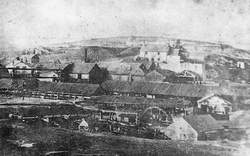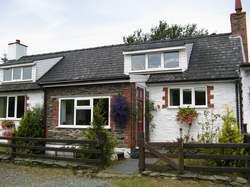Abandoned Communities ..... Dylife
Within a few years the new company had done a great deal to develop the operation of the mines. New shafts were dug vertically so that cages could be installed to lower and raise the miners and to bring up the wagons containing ore. In other lead mines at that time miners would descend at an angle by ladder, and the ore was still being drawn up in large buckets known as kibbles. Another waterwheel was put in place to provide power to a system of metal ropes that transported ore over a mile from two mine shafts to the dressing floors. Changing rooms were provided, Dylife being the only mine in mid Wales, north Wales, or Shropshire to have such a facility.
In 1864 it became possible to transport lead ore to the smelters more rapidly and economically. The railway line from Aberystwyth to Shrewsbury was opened, with a station at the village of Llanbrynmair. Llanbrynmair was eight miles from Dylife, but the road to it was far superior to the mountain track over the mountains to Derwenlas and for the most part followed a gentle downward slope.
During the same period the population of Dylife continued to grow. By 1860 the community showed signs of becoming more stable rather than simply comprising residents who came and went according to the opportunities for employment. An Independent chapel had existed at Dylife for some time, but additional places of worship were a Methodist chapel (opened in 1841), a Baptist chapel (1852), and St David's Anglican church (1856). A vicarage was built in 1857, and in the same year a school was opened. The new company was required to pay £25 per year towards the costs of the school.
The log book for Dylife school can be seen today in the Powys County Archives. Michael Brown, in the book cited above, has quoted several entries in the log book, including comments from an Inspectors Report of 1873. The inspectors reported that reading was good and writing fair "considering that this is a thoroughly Welsh parish", but they were not at all happy with the teaching of arithmetic and insisted that the granting of a certificate to the teacher should be deferred until better results were obtained in this subject.
In addition to providing funding to the school the company were obliged to build new housing for its employees. Houses were in fact scattered throughout the area of the mines, but in particular there were rows of cottages towards the western end of the village (at Rhanc-y-mynydd) and at the eastern end (Bryn Golau). By 1864 the population was about 1000.
Other facilities in Dylife included the Llwyn y Grug Inn and the Star Inn, as well as the aforementioned Drop Inn. The innkeeper at Llwyn y Grug also ran a grocery and a butcher's shop. There was a post office and a smithy. A fair was held once a month, when traders from Machynlleth and Llanidloes set up stalls and the shoe makers of Llanbrynmair did very good business. A favourite place of entertainment was the local cockpit.
I have not come across any reference to medical services at Dylife. Michael Brown has noted that headstones in the graveyard indicate that many men died between the ages of 36 and 40. Health and safety conditions in the mines would in general have left a very great deal to be desired, but in particular there would have been a high incidence of lead poisoning, among those staff working above ground as well as the miners themselves. The inhabitants of Dylife would have absorbed lead through the food they ate, the water they drank, the air they breathed, and the soil and dust they touched. Once inside the human body lead inflicts severe damage on the production of blood, the internal organs, the enzyme systems, the nervous system, and the brain. At high levels lead poisoning will cause coma, convulsions, and death.
In 1864 it became possible to transport lead ore to the smelters more rapidly and economically. The railway line from Aberystwyth to Shrewsbury was opened, with a station at the village of Llanbrynmair. Llanbrynmair was eight miles from Dylife, but the road to it was far superior to the mountain track over the mountains to Derwenlas and for the most part followed a gentle downward slope.
During the same period the population of Dylife continued to grow. By 1860 the community showed signs of becoming more stable rather than simply comprising residents who came and went according to the opportunities for employment. An Independent chapel had existed at Dylife for some time, but additional places of worship were a Methodist chapel (opened in 1841), a Baptist chapel (1852), and St David's Anglican church (1856). A vicarage was built in 1857, and in the same year a school was opened. The new company was required to pay £25 per year towards the costs of the school.
The log book for Dylife school can be seen today in the Powys County Archives. Michael Brown, in the book cited above, has quoted several entries in the log book, including comments from an Inspectors Report of 1873. The inspectors reported that reading was good and writing fair "considering that this is a thoroughly Welsh parish", but they were not at all happy with the teaching of arithmetic and insisted that the granting of a certificate to the teacher should be deferred until better results were obtained in this subject.
In addition to providing funding to the school the company were obliged to build new housing for its employees. Houses were in fact scattered throughout the area of the mines, but in particular there were rows of cottages towards the western end of the village (at Rhanc-
Other facilities in Dylife included the Llwyn y Grug Inn and the Star Inn, as well as the aforementioned Drop Inn. The innkeeper at Llwyn y Grug also ran a grocery and a butcher's shop. There was a post office and a smithy. A fair was held once a month, when traders from Machynlleth and Llanidloes set up stalls and the shoe makers of Llanbrynmair did very good business. A favourite place of entertainment was the local cockpit.
I have not come across any reference to medical services at Dylife. Michael Brown has noted that headstones in the graveyard indicate that many men died between the ages of 36 and 40. Health and safety conditions in the mines would in general have left a very great deal to be desired, but in particular there would have been a high incidence of lead poisoning, among those staff working above ground as well as the miners themselves. The inhabitants of Dylife would have absorbed lead through the food they ate, the water they drank, the air they breathed, and the soil and dust they touched. Once inside the human body lead inflicts severe damage on the production of blood, the internal organs, the enzyme systems, the nervous system, and the brain. At high levels lead poisoning will cause coma, convulsions, and death.
Three
Dylife mines in the late nineteenth century
Part of Rhanc-y-Mynydd
Two cottages at Rhanc-y-Mynydd after restoration


